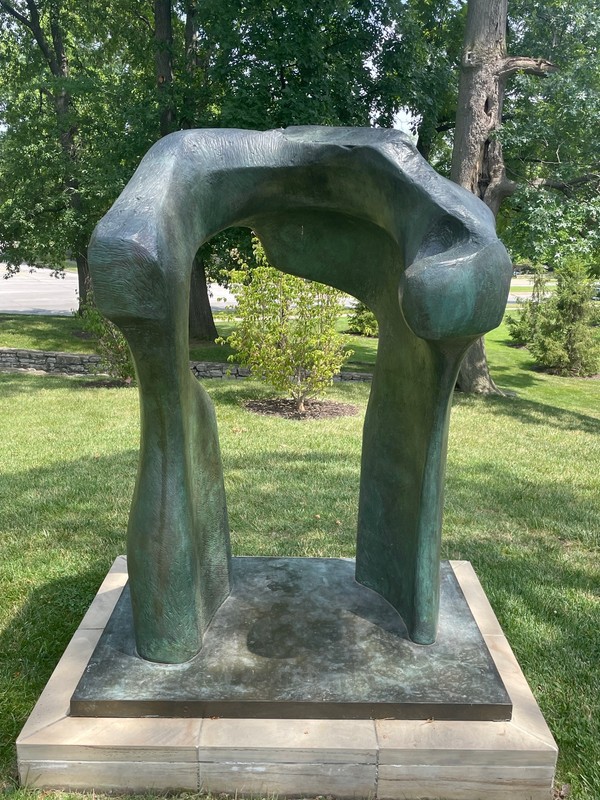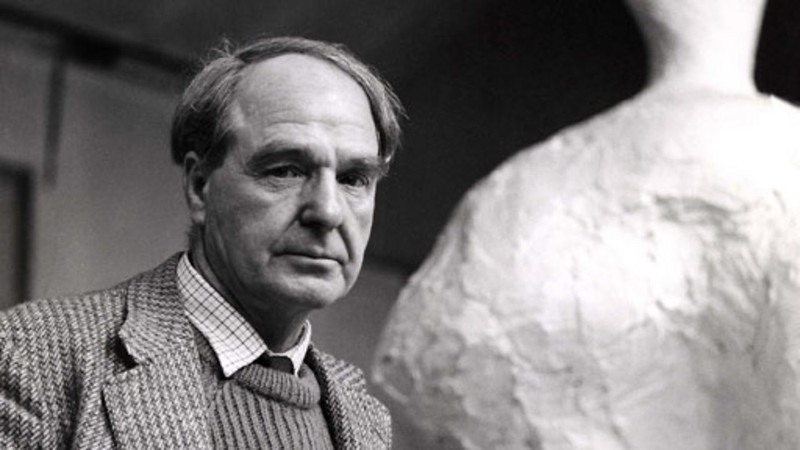Large Torso: Arch
Introduction
Text-to-speech Audio
Cast in 1963, Large Torso: Arch by Henry Moore depicts a hollow, skeletal structure in the form of an arch. Moore created the silhouette based on the bone structure of the tensed shoulders of a male torso, and the work's monumental size and overall shape seem to echo Stonehenge, a formation for which Moore had a special appreciation. Though his signature motifs are that of mother and child and reclining figures, the concept of Large Torso: Arch can be seen in Moore's work as early as 1932 through his drawing Ideas for Sculpture: Transformation of Bones. From an early age, Moore was inspired by Rodin’s “complete understanding of the body’s internal structure” and became fascinated with the human figure. After moving to a rural farmhouse in 1940, Moore began to explore the analogies between the body and landscape, later creating his larger sculptures to be displayed outdoors. This bronze is one of seven editions by Moore and was gifted by the Hall Family Foundation.
Images
Large Torso: Arch by Henry Moore at the Nelson-Atkins Museum of Art, Kansas City, Missouri

Henry Moore

Backstory and Context
Text-to-speech Audio
Best known for his abstract reclining figures and Shelter Drawings, English artist Henry Moore (1898-1986) was a pioneer for Modernism in sculpture and one of the most recognized British sculptors of the twentieth century. Moore showed a talent for drawing early on and at age 11 decided he wanted to become a sculptor after learning about Michelangelo. He received an ex-servicemen's grant after serving in the British Army during WWI, and quickly enrolled in the Leeds School of Art. There, he completed a two-year drawing program in one year before transferring to the prestigious Royal College of Art in London where he studied sculpture.
Moore became fascinated with the human form based on his admiration of Rodin’s belief that the body was the basis for all sculpture. He developed an abstract style of sculpting early on, often using the female form which was inspired by the sense of stability and protection of his mother, also commonly seen through his mother-child theme. By 1931, Moore began gaining a reputation as an Avant-garde, however, there were conflicting opinions and criticism of his unconventional aesthetic.
In 1940, Moore moved from London to Perry Green, Hertfordshire with his wife Irina, where they rented half of a rural farmhouse called Hoglands. Soon after, the sale of Reclining Figure (1939) earned enough money to buy the property outright, and they remained there for the rest of their lives. Reclining Figure would go on to be one of Moore’s most notable signature forms. He converted the outbuildings at Hoglands into art studios but the war limited supplies for sculpting, so he started drawing again. Often traveling back to the city using the London Underground rail system, Moore was moved by the huddling crowds sheltering in the tunnels from air raids during The Blitz - their resting silhouettes and intimate protection for one another were reminiscent of his previous work. He was then recruited as an official war artist and produced a commiserating series of drawings which would become one of his most superlative accomplishments, known as Shelter Drawings.
After the war, Moore returned to sculpture. He started exploring the relationship between the human form and nature that was inspired by the rolling landscape surrounding Hoglands, and the birth of his daughter in 1946 reignited the mother-child theme in his work. That same year was his first international retrospective and in 1948, he won the International Sculpture Prize at the 24th Venice Biennial for representing the optimistic, humanist values embodied in modernism. The following decades brought new materials, heightened creativity and abstraction, increased size, and global demand. During the 60s alone, Moore produced over 200 sculptures, including the six-and-a-half-foot tall Large Torso: Arch.
Throughout his six decade-long career, Moore created nearly 5,500 drawings, 700 graphics, and more than 1,000 sculptures in a variety of mediums. His legacy is carried on in museums and public spaces around the globe, and through the work of the Henry Moore Foundation, established by Moore in 1977.
Gallery Label for Large Torso: Arch
“Henry Moore said, "It is no longer necessary to close down and restrict sculpture to the single, static unit." In Large Torso: Arch, which frames a view of nature, it is space that opens and activates the form. The single arch is an unusual motif within Moore's oeuvre. It fuses organic, biomorphic form with one of the oldest architectural motifs, the arch.”
Sources
Large Torso: Arch, The Nelson-Atkins Museum of Art. Accessed September 1st, 2022. https://art.nelson-atkins.org/objects/25166/large-torso-arch.
The Arch, Henry Moore Artwork Catalogue. Accessed September 1st, 2022. https://catalogue.henry-moore.org/objects/15010/the-arch.
Henry Moore, Large Torso: Arch 1962-63, Museum of Modern Art. Accessed September 1st, 2022. https://www.moma.org/collection/works/81667.
Web Archive: Henry Moore Works in Public, Henry Moore Foundation. Accessed September 1st, 2022. http://webarchive.henry-moore.org/works-in-public/world/united-states-of-america/new-york/museum-of-modern-art/large-torso-arch-1962-63-lh-503.
Interview: Henry Moore talks about Rodin's irresistible influence - from the archive (1970), The Guardian. March 23rd, 2013. Accessed September 1st, 2022. https://www.theguardian.com/artanddesign/2013/mar/23/henry-moore-auguste-rodin-exhibition.
Parry, Alison. Henry Moore: The Sixties, Henry Moore Foundation. February 22nd, 2022. Accessed September 1st, 2022. https://www.henry-moore.org/press-office/press-release/2022/02/02/henry-moore-the-sixties.
The Collection of A. Alfred Taubman: Masterworks / Lot 71, Sotheby's. Accessed September 1st, 2022. https://www.sothebys.com/en/auctions/ecatalogue/2015/masterworks-collection-a-alfred-taubman-n09430/lot.71.html.
Photo by David Trowbridge
https://www.bbc.co.uk/archive/henry-moore/znkkf4j
